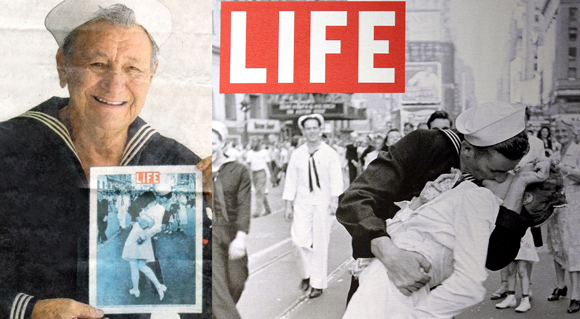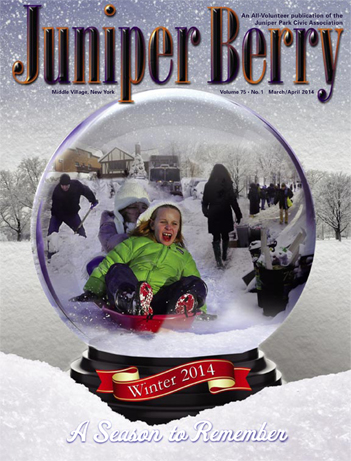You don’t know his name, but you definitely know his image. His name is Carl S. Muscarello, ‘Moose’ to his family and friends. His image is a sailor in Times Square on V-J Day, August 14, l945, planting a smooch on a nurse-much to her surprise- and captured by a photographer for Life Magazine.
Many other men have claimed to be this sailor in what may be one of the world’s most famous photos, and they have good reason to believe they were the one. Times Square was all mayhem and joy that day, as thousands of civilians and military personnel celebrated the surrender of Japan and the end of the world’s worst war. As Muscarello said, “I was eighteen at the time, and one beer would have made me drunk; I must have had twelve beers that day!” and so we can presume so too did numerous other men in uniform. And there was more than one photographer snapping pictures, so the same scene may have repeated itself many times-sailor grabbing nearest ‘dame’ to celebrate.
My family met Carl in the mid 90’s at a local country club where World War II era big band music was being played, and “that sailor in that picture with the nurse was there!” signing autographs, as they told me when they arrived home. I am the son of a World War II veteran and was studying for a history major at the time, so naturally this caught my attention and I decided to give the man a call. Carl lived a few blocks from my house as it turned out.
After reading his story, and meeting him in person, I became convinced rather quickly he was indeed the man in the photo. He told me that he always knew it, but never made a stink of it, though his family always urged him to come forward. The nurse’s identity, incidentally, has always been known because she stayed and talked with the photographer, whereas the sailor disappeared into the partying crowd (perhaps for a few more beers and kisses!) Her name is Edith Shain, and she had spent decades interviewing dozens of men claiming to be ’the one’ only to reject them all, Her litmus test was a number of questions that all failed to answer correctly, and so they could not have been this particular sailor in this photo.
50th anniversary of the end of the war
When the 50th anniversary of the end of World War II came in 1995, Muscarello’s family put intense pressure on him, like never before, to come forward with his claim. And so he did, feeling a sense of obligation to history. He was of course obligated to run the test of Edith Shain who could determine the validity of his claim.
Carl visited Edith in Santa Monica, California and got cross-examined: “How come you never called me? I gave you my phone number!” asked a disappointed Edith, and Carl’s answer was, “Call you? You never gave me any number!” Then why didn’t you answer when I called you?” Edith asked, and again Carl said, “I never gave you my number!” Carl was passing the test, though it was far from over. “Why did you grope me?” Carl was mortified at this question and retorted, “GROPE YOU?’ Guys didn’t do things like that, especially not ME! My father would have KILLED me if I did something like that.”
Another hurdle of a questions cleared by Carl. But there was still another question that Carl needed to answer, one every other claimant failed to answer correctly.
Edith put it to him, “What exactly did you say to me when you finished kissing me?”
Edith had the full gamut of possible answers from all other interviewees, such as, “I love you!” “Marry me toots!” or “God Bless America!” But none of these or any other creative phrases was uttered by the mystery swabbie that day. What, exactly, was the answer Edith was looking for all these years?
The answer came plain and simple from Muscarello: “Lady, I didn’t say anything at all. I kissed you, walked away, and that was it. “Edith jumped to her feet in an emotional fit, bouncing all over her home and proclaiming: “Oh my God! Oh my God! YOU are the one, YOU are him!”
This is how the nurse has come to verify that Muscarello was ‘the one.’ For one thing, he refuses to make money from this event and he has had numerous opportunities to do so. Carl has literally been given $1,000 from a Chamber of Commerce, and refused to cash it. Why? As Carl has told me so many times, “I won’t make money off World War II. It was a horrible event. Many of my childhood friends were killed and I am not going to make money from it .” In fact, Carl has spent large amounts of his own money printing photo-quality copies of this image which he signs for anybody, free. He feels an obligation to history to teach about World War II, and the sacrifices our boys made for freedom. He turns down agents and contracts and money, and does talks and interviews without charge.
Carl Speaks to My Students
I invited Carl to speak to my junior American history students in the spring of 2001, and his presentation was something I will never forget. My students were particularly difficult that year to teach. Dreadful is more like it, and no matter what I tried, from showing interesting videos to bringing in my valuable collection of historic items, I failed to make an impact on my students who preferred to talk and goof around. So I took the gamble on bringing Carl in as a guest speaker. I not only warned my students to behave, but also warned Carl that they probably won’t behave, and for him to expect a rude lot of rascals.
Carl arrived very well-dressed – he always is. This was the first thing that seemed to impress my students, especially the girls. One girl said, “I hope my husband looks that good when he’s that age!” and another responded, “I hope my husband looks that good when he’s twenty-five!”
Carl spent a good thirty minutes talking about this photo and how he managed to end up in it. “If you were in uniform that day, you were gonna get kissed by a hundred girls!” to the laughter of everyone. And he described in detail this day and this moment, convincing my class that indeed he was the man in the photo. But I felt all along that something was missing from his talk and indeed there was – the horror of World War 11 and how American sacrifice saved the world. I knew I had to bring this up and I did so in a way that made a tremendous impact.
“Muscarello,” I asked, “did you ever know anyone who was killed in World War II?” and of course I knew the answer and suspected the possible way he would answer this. Carl stood still for about a minute, turning red, with tears welling up in his eyes while my entire class (and another visiting class and several other teachers) sat in utter silence, some of them also with tears in their eyes. “Gene, “Carl responded, “all my friends that I knew growing up were killed, everyone!” Then he gave his response, with great effort, choking and sobbing as he answered. “All my buddies from Brooklyn, all the guys that hung out on the stoops and lied about girlfriends they didn’t have, all my friends. ALL of them were killed!” He listed a long line of very Italian names one after another and where they were killed: “so-and-so killed in the Bulge, so-and-so killed at Iwo Jima” and on and on.
As Carl named these friends, he walked around my classroom pointing to students saying, “so-in-so killed in Germany, so you don’t have to speak German …so-in-so killed at such and such island in the Pacific, so you don’t have to speak Japanese, so-in-so killed so you can come to this Catholic school and worship as you wish…” and so on. He then told the kids that not a day has gone by in over fifty years that he has not thought of his friends, the “real heroes” as he called them, was in his head. “I’m no hero,” he told them,”this is the only ‘action’ I saw!” as he pointed to the kiss in the photo while a burst of laughter broke the intensity in the room. It was a ‘moment’ if I had ever seen one, a powerful bit of teaching that I could not accomplish even one-tenth of through my own efforts with footage of World War II, my father’s G.I. helmet and other paraphernalia of the war.
This, more than any other ‘test’ told me Carl was the man in the photo. The humble, sincere and profound testimony that day convinced me that surely there is no reason to believe he is not the man, or that he is not making it up and certainly believes with good reason it is he. And of course Carl stayed and signed more than sixty photos, all personalized, and all paid for from his own pocket.
My students were almost all Cuban-American, sons and daughters or grandchildren of immigrants who fled the Castro regime. The students, from their own testimony, did not see themselves as Americans, but rather as Cuban exiles, despite the fact that they were all born and raised here in America. “We’re going back when Castro dies.” is what I had been told many times, to which I had to point out that “going back” implies that they had come from Cuba, which they did not. In addition, they all rooted for the Cuban national school the next day, proclaiming, “we won” to which I replied, “We?” Are you not Americans?” and pointed out to them that Castro, as well , was rooting for the same team, which was something they apparently had not considered.
But I believe many, or at least some, of my students became Americans that day. I believe there are really two kinds of citizenship: one is just because you are born here; the other is the kind where regardless of how you got here – by birth or by boat – that you willfully love and embrace this land as your own. The latter, in my opinion, is the ‘real’ citizenship, and I think that day with ‘Moose’ may have sent some of these kids on the path to such a citizenship.
Editor’s Note: Carl S. Muscarello is the younger brother of Ceil Carrano, a longtime member and volunteer of the Juniper Park Civic Association and resident of Middle Village. Many people have come forward and claim to be the sailor and nurse in the famous photo. We will leave it up to our readers.




